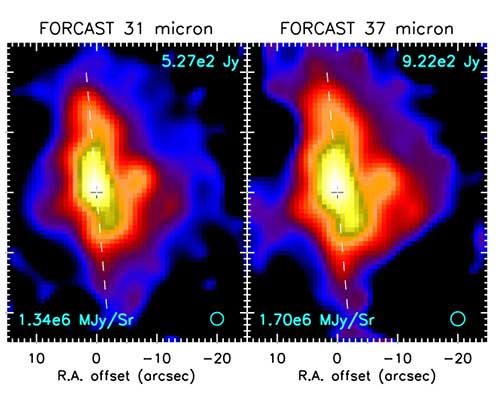The star G35.20-0.74, commonly known as G35, is one of the most massive known protostars and is located relatively close to Earth at a distance of 8,000 light-years.
Until now, scientists expected the formation process of massive stars would be complicated by the turbulent, chaotic environments in the centers of new star clusters where they form. But observations of G35 suggest this giant star, more than 20 times the mass of our Sun, is forming by the same orderly process as do stars with the same mass as the Sun. Stars most like the Sun are understood to form by simple, symmetric collapse of interstellar clouds.
“The focus of our study has been to determine how massive stars actually form,” said Yichen Zhang of the University of Florida in Gainesville. “We thought the G35 protostar’s structure would be quite complicated, but instead we found it is simple, like the cocoons of protostars with the Sun’s mass.”
The observations of G35 were made in 2011 with a special camera aboard SOFIA, a modified Boeing 747SP aircraft that can carry a telescope with an effective diameter of 100 inches (2.5 meters) to altitudes as high as 45,000 feet (13,700 meters).
G35 was an ideal target for investigations because it is in an early stage of development. But infrared light coming from G35 is so strong that it prevented infrared space telescopes from making detailed images. Also, the protostar is embedded so deeply in its natal cloud that it cannot be detected by optical telescopes observing from the ground at visible wavelengths.
Flying high above the light-blocking water vapor in Earth’s atmosphere, the airplane-mounted Faint Object Infrared Camera for the SOFIA Telescope (FORCAST) enabled astronomers to see G35 where it hides — inside a dark, dense, interstellar dust cloud — by collecting infrared light escaping the cloud. Uniquely suited for this work, FORCAST detected faint details next to bright structures at wavelengths inaccessible to any other telescope on the ground or in space.
“Massive stars, although rare, are important because there is evidence they foster the formation of smaller stars like our Sun, and because at the ends of their lives they create and distribute chemical elements that are the basic building blocks of Earth-like planets,” said James De Buizer from NASA’s Ames Research Center in Moffett Field, California.










